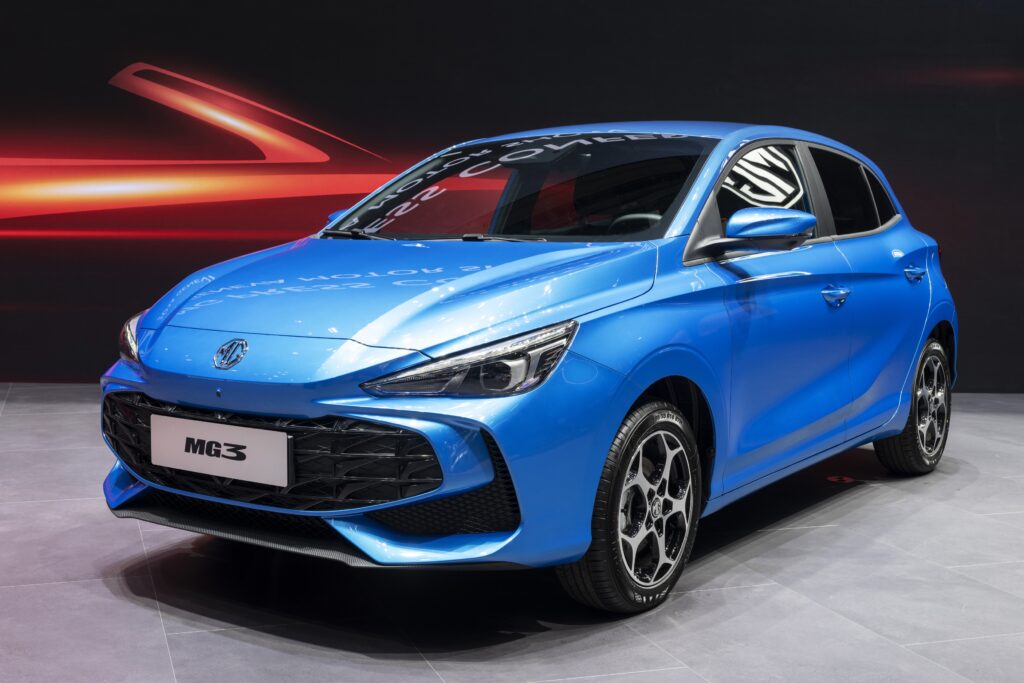Hybrids record highest-ever share in German new-car market as ICE collapses
08 October 2024

Hybrids, including full (HEVs) and mild hybrids (MHEVs), recorded their highest-ever monthly share of the German new-car market in September. Meanwhile, internal-combustion engine (ICE) volumes slumped. Tom Hooker, Autovista24 journalist, analyses the figures.
A total of 208,848 new cars took to Germany’s roads in September, a decline of 7% year on year. This marks the lowest September total since 2021, largely due to declining deliveries of petrol and diesel models.
According to data provided by the Kraftfahrt-Bundesamt (KBA), September was the third consecutive month of decline and one of five delivery drops so far this year. Year to date, the German new-car market was down 1% with just under 2.12 million registrations.
‘It is worrying for the automotive trade that the total number of new passenger car registrations declined again in September,’ said German Central Association for Motor Trades (ZDK) vice president Thomas Peckruhn. ‘This applies to both private and commercial registrations.’
Hybrid’s all-time high
However, despite a poor result overall, the hybrid market saw registrations rise 4.7% in September, with 60,497 units.
The powertrain recorded a market share of 29% in the month, its best-ever result. This was up 3.3 percentage points (pp) on the same period last year. This follows two record results of 28.3% in August and 27.3% in July. Before then, the best market share performance for hybrids came in October 2023, at 26.3%.
In the first nine months of the year, the technology reached 545,301 deliveries, up 11.1%. Hybrids accounted for 25.8% of new-car registrations in this period, up 2.8pp year on year.
Dreadful diesel result
In contrast, diesel had a dreadful September. It was the worst-performing powertrain in the month, slumping 22% with 31,115 deliveries, equating to a drop of almost 8,800 units.
September was the second consecutive month of double-digit decline for diesel. Volumes were down 24% year on year in August.
The powertrain’s market share of 14.9% in September was its lowest result since August 2023. This period was skewed by BEVs leading the market due to an incentive pull-forward effect.
Diesel also posted the biggest year-on-year drop in market share so far in 2024, down 2.8pp. This was just ahead of January at 2.7pp.
From January to September the fuel type was still up 1.3% with 379,548 registrations. However, this was down from growth of 4% in the first eight months of the year. Its year-to-date share was 17.9%, up 0.4pp from the same period in 2023.
Petrol struggles
Petrol was the second-worst-performing powertrain in September. With 67,009 deliveries, it saw deliveries drop 15.2% year on year, down nearly 12,000 units.
September was petrol’s lowest monthly total since December 2022 and the biggest year-on-year volume drop for a month since July 2022. The latter month saw production slump because of external factors, including a shortage of parts and surging raw material prices.
It captured 32.1% of the new-car market last month, down 3.1pp. This was the biggest monthly market share drop of 2024 so far when compared to the same period last year.
In the year to date, petrol reached 770,999 registrations, an increase of 2.7%. In this period, the powertrain took a 36.4% market share, up from 35.1% during the first nine months of 2023.
ICE idles
Unsurprisingly, the ICE market, including petrol and diesel, fell 17.5% in September, with 98,124 deliveries. This was the powertrain grouping’s lowest monthly total and biggest percentage drop so far this year.
The September share of 47% was its smallest since December 2023 and 5.9pp below its result from 12 months ago. This was ICE’s biggest year-on-year drop in market share during the first nine months of 2024.
From January to September, the powertrain was up 2.3% with over 1.15 million registrations. However, this was down from the 4.6% improvement recorded across the first eight months of the year. It held a market share of 54.4% in the year to date, an increase of 1.8pp compared to the same period in 2023.
Germany’s ICE struggles follow similar trends seen in France and Italy. The former suffered a delivery drop of 33.3% last month, while ICE volumes in Italy plummeted 23.7%. Furthermore, the UK’s ICE market fell 9% last month. This was particularly concerning, as the country incorporates mild-hybrid models with their relevant petrol and diesel figures.
BEVs back on track?
Battery-electric vehicles (BEVs) saw registrations grow 8.7% in September to 34,479 units. This meant it was the month’s best-performing powertrain, excluding the small volume ‘others’ category. This is a feat it has not achieved so far this year. September also marked BEV’s first year-on-year increase since January.
However, last month's improvement was distorted by a poor performance from the technology in September 2023, when BEV purchase incentives were removed for businesses.
Comparing last month’s figure with September 2022, the powertrain declined 22.3%. So, despite initially looking positive, the BEV market is clearly still suffering.
BEVs took a market share of 16.5% last month, up 2.4pp. This was the biggest monthly year-on-year share gain so far in 2024. It is also the technology’s highest share since December 2023. However, in this month, BEV figures were heavily skewed by the sudden removal of private incentives.
The powertrain was still down 28.6% in the year to date, with 276,390 deliveries. It accounted for 13.1% of all registrations during the first nine months of the year, down 5pp.
No trend reversal
‘The slight recovery of BEVs does not represent a trend reversal yet. So far this year, there is still a significant minus here. Temporary market incentives will not be sufficient to perpetuate an upward trend’ commented Peckruhn.
‘Instead, it is important to massively expand the charging infrastructure, reduce the cost of charging electricity, continue to spread the company car tax according to drive types, and quickly implement intelligent support measures for the sale of new and used electric vehicles (EVs) as well as the expansion of the charging infrastructure,’ he continued.
‘The purchase of EVs is still too expensive for many customer groups and confidence in a tailor-made charging infrastructure is also not pronounced. So, there is still a lot to do for the German government and the EU Commission to improve the economic framework conditions given the still sluggish ramp-up of e-mobility,’ Peckruhn explained.
Looming CO2 targets
There are also concerns surrounding EU CO2 fleet targets for 2025. ‘The automotive industry plays a central role in achieving climate targets, and international motor vehicle manufacturers in Germany strongly support CO2 neutrality by 2045,’ stated André Schmidt, president of the Association of International Motor Vehicle Manufacturers (VDIK).
‘However, we are experiencing a bitter setback in the drive turnaround, especially due to the ongoing slump in the number of registrations for battery-electric vehicles,’ Schmidt added.
The latest CO2 target for manufacturers comes into effect from next year until 2029. The EU-wide fleet target will be 93.6g/km instead of 95g CO2/km, which has been applied since 2020.
‘The CO2 fleet limits planned for 2025 represent a further obstacle to the ramp-up of electromobility, as they are based on assumptions that have not materialized. The European Commission must now take concrete countermeasures and bring forward the reviews for passenger cars and commercial vehicles by one year each,’ Schmidt highlighted.
PHEV decline
Plug-in hybrid (PHEV) deliveries declined 2.9% in September with 14,936 units. Yet, it recorded a monthly market share of 7.2%, the technology’s best result since December 2023. This was also ahead of its 6.9% share from 12 months ago.
In the year to date, PHEV deliveries were up 7.7% with 132,861 units. It captured 6.3% of the new-car market from January to September up from a 5.8% share during the same period last year.
Combining BEV and PHEV volumes, the EV market improved 4.9% in September with 49,415 registrations. This performance ended four consecutive months of decline and is only the third increase for the powertrain grouping this year.
The plug-in market share sat at 23.7% in September, the highest since December 2023. This was up 2.7pp on September last year, the highest year-on-year increase so far this year and the first improvement since January.
However, from January to September, 409,251 EV deliveries equated to a 19.9% slump. Plug-ins made up 19.3% of new-car registrations in the first nine months of the year, down 4.6pp.
Electrified market accelerates
Adding plug-ins to the hybrid share, the electrified market made up 52.6% of new-car volumes in September, up 5.9pp year on year and 5.6pp ahead of the ICE share. In the first nine months of the year, electrified vehicles captured 45.1% of deliveries, down 1.7pp year on year and 9.3pp behind the ICE market.
The ‘others’ category, including fuel-cell electric vehicles, natural gas and liquified petroleum gas vehicles, E85/ethanol and other fuels, grew 11.1% in September with 812 registrations. Yet, this equated to an increase of just 81 units. The powertrain grouping took a 0.4% market share last month, up 0.1pp.
In the year to date, 10,975 deliveries for the category equated to a 3.4% decline. Its market share was stable in this period compared to last year at 0.5%.




